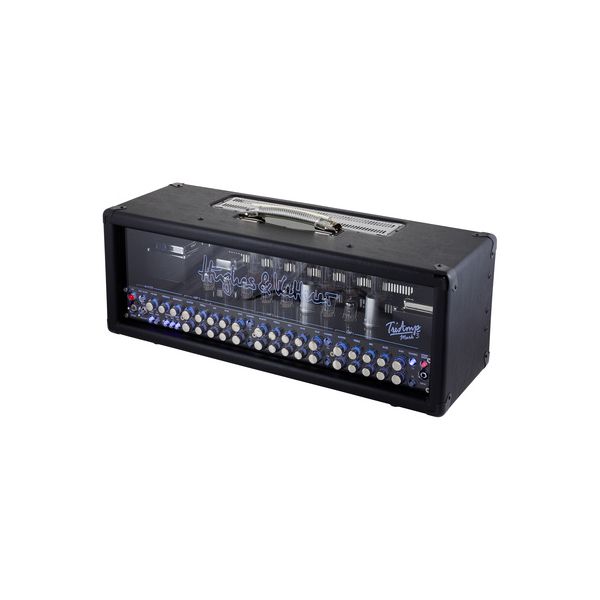+ AUSGEPACKT +
Zunächst war ich positiv darüber überrascht, wie viel Zubehör Hughes & Kettner ihrem Flaggschiff beilegen. Das Handbuch (und Buch stimmt hier tatsächlich) ist sehr nett und praxisnah geschrieben – weder Fachchinesisch noch zu offensichtliches á la "Der Volume-Knopf regelt die Lautstärke". Es werden auch Tipps zu Endstufenröhrenkombinationen gegeben. Lest euch die ruhig mal durch, ist interessant!
Aber ein Handbuch konnte man ja erwarten. Dass ein Aufkleber dabei ist, ist nett, aber nicht kriegsentscheidend. Der mitgelieferte Fußschalter allerdings schon. Wer sich mal die Preise von Midi-Boards angeguckt hat, weiß, dass man für sowas mindestens 120€ ausgibt – is dabei, is toll. Genau wie das 9m 7-Pin Midikabel (5pin Midi + Stromversorgung, normale Kabel gehen aber auch). Die Innovationen, für die Hughes & Kettner bekannt sind, merkt man hier ebenfalls, wenn auch eher in den Nebensächlichkeiten: es ist nämlcih ziemlich egal, was für ein Netzteil man verwendet (nur bei 5pin MidiKabel notwendig, da ohne Phantomspeisung). Man kann alles zwischen 9 und 15V anschließen, egal ob Gleich- oder Wechselstrom, Polung ebenfalls egal. Warum machen das denn bitte nicht alle?
Über das Midi-Board haben sich auch schon einige Reviews ausgelassen. Was mich aber überrascht hat, war, dass eine Schutzhülle beiliegt (etwa in Gigbag-Wandstärke), Putzzeug für die Plexiglasscheibe, damit man die nicht mit Spülschwämmen o.ä. verkratzt und eine Anodensicherung. Muss alles nicht. Is aber alles toll.
+ ANGEGUCKT +
Das Gerät an sich ist natürlich schon sehr schick. Da ich selbstverständlich auch jedes verfügbare Review in deutsch und englisch gelesen, gehört und geguckt habe, wusste ich natürlich längst, wie mit der Masse der Knöpfe umzugehen ist. Wäre sonst aber auch für jeden denkenden Menschen in 3 Minuten klar...
Interessant fand ich das NoiseGate (bisher hab ich das immer über meinen GMajor2 gemacht). Das funktioniert auch wirklich gut, wenngleich ich, obwohl ich meist laut Metal spiele, den Regler (wie hart das Gate zumacht) eher sanft eingestellt habe. Reicht schon.
Was auch nett ist, ist, dass es einen DI-Out gibt. Benutze ich zwar nicht, aber vielleicht braucht man das ja mal.
Was wirklich cool ist, sind die zwei Effektwege. Zunächst hat man einen per Midi schaltbaren FX Loop (parallel oder seriell – auch per Midi schaltbar), das kennt man ja. Zusätzlich hat man aber danach noch einen Master-Insert für ständig aktive Geräte wie Tuner oder in meinem Fall den Sonic Maximizer von BBE, um den Sound noch etwas einzufetten.
Also: Vorverstärker –> FX-Loop –> Master Insert –> Endstufe
Neben den einzelnen Kanalzügen gibt es noch die Master-Sektion, in der man global Lautstärke, Tiefen ("Resonance") und Höhen ("Presence") einstellen, damit man in anderen Räumen, auf Bühnen usw nicht jeden einzelnen Kanal soundmäßig anpassen zu müssen.
Wovon ich noch nicht viel gemerkt habe, ist das TSC (Tube Safety Control). Das stellt automatisch die richtigen Ströme für die Endstufenröhren ein. Hab ich keine Ahnung von. Aber wenn man davon nichts merkt, kann das ja nur gut sein. Toll auch, dass man jetzt einen Röhrenwechsel selbst vornehmen kann, weil der Amp die Röhrenströme ja selbst einmisst und einstellt. Schade für Gitarrenläden, schön für mich. Darüber hinaus kann man offenbar so ziemlich jede Röhre reinstopfen, die man so findet. Wer da genaueres wissen will, kann im Handbuch nachlesen.
Dass man beim Triamp3 auch die Endstufenröhren wechseln kann, dürfte mittlerweile bekannt sein, ist ja schließlich H&Ks großer Werbeaufmacher...
Ein weiteres tolles Feature ist der Stomp-Box-Vor-Vorverstärker. Dazu aber weiter unten.
Ihr merkt schon, es gibt wahnsinnig viele Features, die allesamt schlau, durchdacht und praxisnah umgesetzt sind.
...hoffentlich kann ich den Rest meiner Bewertung noch in einem zweiten Teil loswerden...




)
)
)


